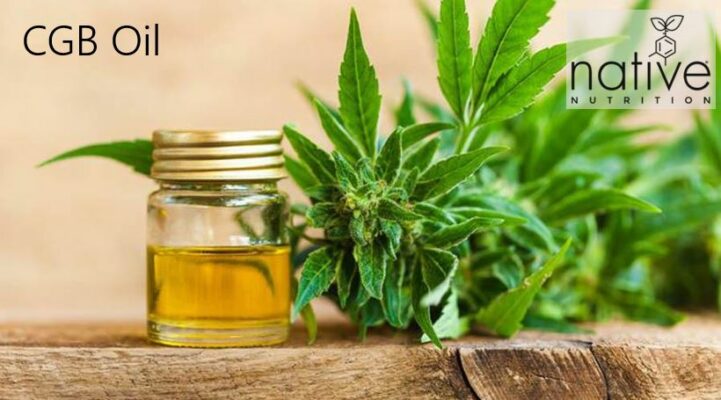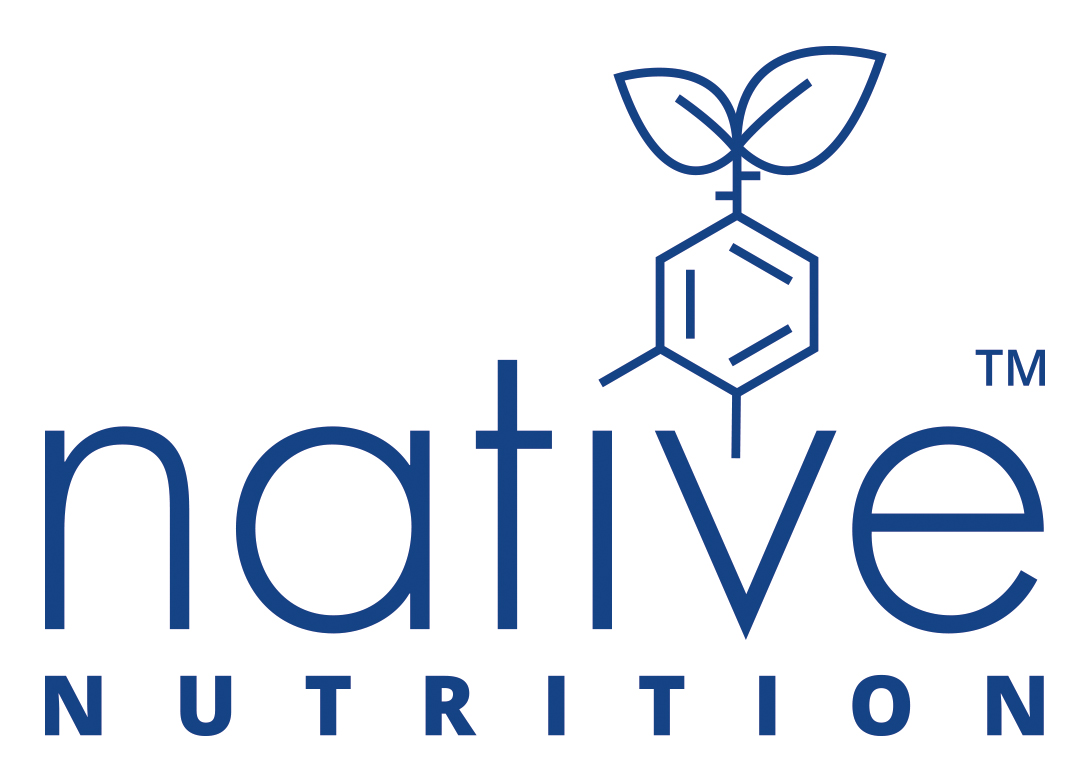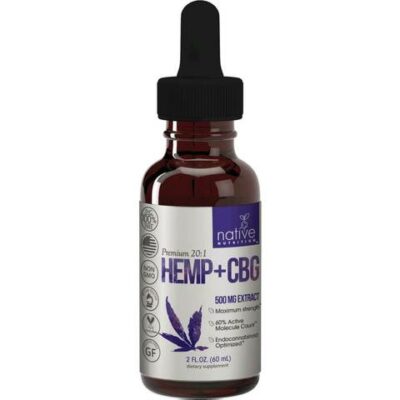What is CBG Oil?

CBG is a cannabinoid, a naturally occurring compound that is present in hemp and cannabis plants. There are more than a hundred cannabinoids in these plants. CBG oil is derived via extraction from a hemp or cannabis plant. This extraction is often mixed with a carrier oil (such as MCT oil) in order to produce an edible or topical product.
CBG oil drops may not get as much attention as CBD, but a growing body of research suggests it offers many of the same benefits—and then some. Here’s the low-down on what CBG is, how it acts in the body, CBG oil’s benefits and uses, and exactly what distinguishes CBG from CBD. CGB is starting to show up on the radar of researchers and people who are seeking natural management options for a variety of conditions. We’ll touch on the possible benefits of Native Nutrition CBG oil in following sections.
CBG is sometimes referred to as the “mother of cannabinoids,” because it’s thought that many cannabinoids actually start out as a form of CBG. Within the hemp or cannabis plant, CBG starts out in the form of cannabigerolic acid (CBGA), which provides the original material for other cannabinoids. CBGA is synthesized into the likes of THCA, CBDA, and so on. When these compounds are heated up, they drop the “A” (acid) and become the THC and CBD with which we’re all familiar.
This synthesis process happens as the cannabis or hemp plant matures, which helps explain why the amount of CBG in a plant declines as the plant ages—it’s being used up to synthesize other types of cannabinoids.
What does CBG stand for?
CBG stands for cannabigerol, which is simply the official name for this cannabinoid. There’s a reason people use abbreviations for cannabinoids including CBD, THC, and CBG: Their real names can be hard to remember and pronounce!
Like other cannabinoids such as CBD and THC, it’s thought that CBG interacts with the human body’s own endocannabinoid system.
Researchers are still working to understand exactly how cannabinoids in general affect the body’s natural endocannabinoid system. It seems that CBG mostly binds with the body’s CB1 and CB2 receptors. The science here can get really complicated, but the main takeaway is that the way CBG interacts with the body’s endocannabinoid system helps explain why it may have several therapeutic effects for humans.
CBG is non-psychoactive—meaning it doesn’t produce the “high” associated with THC. Thus, CBG may yield therapeutic benefits without any mind-altering effects.
CBG benefits
Now that you understand what CBG is and how it works in the body, let’s talk about why this substance might be beneficial. While research into CBG’s benefits is still in its infancy (and most clinical trials have been conducted on animals), here’s an overview of some of the most promising research so far:
- CBG may offer pain relief. According to a2010 review, CBG may have pain-relieving properties. This is true for other cannabinoids including CBD and THC, but there’s some evidence that CBG may have even more pain-relieving properties than THC.
- CBG may function as a natural muscle relaxant. Per the same 2010 review, CBG may also help relax muscles. For this reason, CBG may be useful for the management of sports injuries or chronic pain.
- CBG may have antidepressant and anti-anxiety properties. Based on the 2010 review cited above, CBG may offer relief from depressive symptoms. There’s also some evidence that CBG may increase natural levels of anandamide (also known as the “bliss molecule”) in the brain, thereby offering anxiety relief.
- CBG may have antibacterial, antifungal, and antimicrobial properties. A number of studies have found that CBG may possess both antifungal and antimicrobial properties. These properties are so potent that CBG can even help fight off MRSA.
- CBG may have a neuroprotective effect. That’s a fancy way of saying CBG may help keep the brain healthy by protecting against cognitive decline. A2015 study suggests this may be true for people dealing with serious neurological conditions such as Huntington’s disease. These same properties may also prove helpful for people with Parkinson’s or Alzheimer’s disease.
- CBG may assist in the management of bladder dysfunction. A2015 study (which was conducted on mice) found that CBG and other cannabinoids may reduce bladder contractions, which could help people with overactive bladder.
- CBG may help strengthen bones. Per a2007 study, it’s possible that CBG may play a role in stimulating bone marrow growth. While more research is needed, this suggests CBG might be able to assist in the healing of bone fractures and possibly protect against osteoporosis.
- CBG may have anti-tumor effects. A few animal studies have suggested that CBG may slow the progression of certain cancers, including breast, colon, and prostate cancers. Additionally, CBG may stimulate appetite, thereby helping to counteract one of the effects of chemotherapy.
- CBG may assist in the management of psoriasis. There’s some evidence that the way CBG interacts with the body’s endocannabinoid system might make it a viable treatment option for psoriasis.
- CBG may soothe inflammatory bowel disease. A2013 study (which was conducted on mice) suggested CBG may reduce inflammation in the lower bowel. Meanwhile, a2018 study found that cannabinoids in general may help turn off the body’s inflammatory response in the gut.
- CBG may assist in the treatment of glaucoma. CBG and other cannabinoids have been shown to reduce intraocular pressure in the eye, which may be useful for people coping with glaucoma.
CBG vs CBD
As we’ve noted, CBG shares a lot in common with CBD (though they’re two distinct compounds). Here are some of the ways in which CBG and CBD are fairly similar:
- Both CBG and CBD are cannabinoids. They are both naturally occurring compounds derived from the cannabis or hemp plant.
- Both CBG and CBD interact with the body’s endocannabinoid system. While researchers are still working to understand the intricate workings of the endocannabinoid system, they do know that both CBD and CBG affect the human body by interacting with this system.
- Both CBG and CBD may have a number of therapeutic effects. Both CBG and CBD have therapeutic effects that are distinct to those compounds, but there is also some overlap. For instance, CBG and CBD have been shown to assist in alleviating pain, relieving anxiety and depression, improving skin health, offering neuroprotective benefits, and assisting in the management of cancer and other health conditions.
- Both CBG and CBD are non-psychoactive. That means neither compound provokes a “high” or mind-altering effect.
Even though there are a lot of similarities between CBG and CBD, it’s important to remember that these are two different compounds with slightly different effects on the human body. There’s some evidence that the beneficial effects of these cannabinoids may be magnified when taken together as opposed to in isolation. This phenomenon is called the “entourage effect.”
CGB Summary
While research into CBG is relatively new, so far studies suggest this non-psychoactive cannabinoid may offer a number of benefits.
Those possible benefits include pain relief, muscle relaxation, relief from anxiety and depression, neuroprotective effects, improvements in skin and bone health, and assistance in the management of a number of conditions including inflammatory bowel disease, overactive bladder, and even cancer. CBG also has demonstrated antibacterial, antifungal, and antimicrobial properties.
If you want to give CBG a try, it’s important to vet companies carefully. As with any supplement, CBG isn’t regulated, which means it’s up to brands to be accountable for quality control—and some brands take this responsibility more seriously than others.
Our broad-spectrum, THC-free CBD oil with CBG is one of the only consistently stable CBD + CBG oils on the market. Our extra-strength formula is extracted from genetically registered hemp plants grown by U.S.-based farmers who pass our rigorous quality control testing, and our CBG oil is processed and bottled in the U.S. in an FDA-certified and GMP-compliant facility.
While many companies have been found to spike their low-grade oils with cheap isolates or synthetic versions from China, we’re committed to making natural, effective products without any useless or dangerous chemicals, fillers, or cheap synthetics.
Finally, our blend of carrier and driver oils enhances absorption up to 15X, which ensures that you enjoy the benefits of CBG (instead of spending your money on a product that doesn’t work). All signs suggest CBG is a safe, non-psychoactive tool for enjoying a number of physical and mental benefits.


